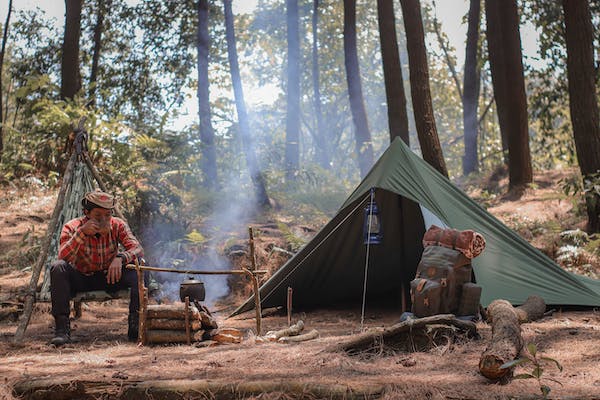The great outdoors beckons with its call to adventure, offering enthusiasts two main avenues: backpacking and hiking. Each presents its unique thrills, challenges, and charms. While the primary distinction between backpacking and hiking lies in one involving camping or sleeping outdoors and the other not, let’s delve deeper into their definitions for clarity.
Defining Backpacking and Hiking:
Backpacking involves extended journeys, carrying all essentials in a backpack, often delving deep into remote terrains, and encompassing overnight stays. Hiking, on the other hand, usually entails day trips or shorter excursions, generally completed within a day.
Backpacking involves loading gear and food into a backpack and hiking to campsites, offering exercise, wellness, and nature immersion, all at a relatively low cost once you’ve acquired the necessary gear.
Backpacking, with a slightly stricter definition, entails an extended hike lasting two or more days, during which individuals must carry all their gear, including shelter, water, and food, on their backs. Essential items like tents, sleeping bags, and food are typically packed, while anything that doesn’t fit is left behind. Conversely, in other regions, ‘backpacking’ refers to traveling with only a backpack, presenting a broader interpretation.
On the eastern side of the Atlantic, the term “backpacking” holds a rather specific meaning, but it’s used in two distinct contexts in Europe. Consider the common scenario of recent college graduates saving to “backpack across Europe” – representing the alternative definition.
In North America, “backpacking” commonly signifies overnight hiking trips along established trail systems within national and state parks or forested areas. At the same time, in other parts of the world, the term denotes extended travel, where individuals limit themselves to what they can carry in a backpack.
This activity holds a relatively flexible definition. Fundamentally, hiking equates to walking outdoors. However, in common usage, hiking entails extended walks amidst natural landscapes, often within state or national parks and forests. While many associate hiking with mountains and picturesque views, these elements are more about aesthetics than the core activity. Essentially, hiking as a hobby involves walking outdoors for exercise, enjoyment, and a deeper connection with nature.
Backpacking and hiking are nearly identical activities, with the primary distinction being that backpacking encompasses camping and requires more expertise. However, to briefly differentiate between “backpacking vs hiking,” consider this: when you’re backpacking, you’re essentially always hiking, whereas when you’re hiking, you’re not necessarily backpacking.
The Allure of Outdoor Adventures:
Both activities offer the promise of connection with nature, physical exertion, and an escape from the mundane, albeit in distinct ways.
The most stringent interpretation of “backpacking,” commonly used beyond the US, refers simply to traveling with only a backpack. In Europe, backpackers utilize trains and hostels, diverging from typical US practices, possibly due to the strong emphasis on the National Parks System in the US.
History and Evolution:
Roots of Backpacking and Hiking
The emergence of backpacking as a recreational pursuit can be traced back to the early 20th century, coinciding with societal modernization and increased focus on workers’ rights, marked by establishing the 40-hour work week and the end of legal child labor. With improving economic conditions and more leisure time becoming available, people sought avenues for outdoor enjoyment. Influential figures like John Muir advocated for the preservation of America’s landscapes alongside the expansion of the national parks system, which grew from 1872 with the designation of the first national park, Yellowstone, to 1920, boasting 15 national parks, including iconic landmarks such as Yellowstone, Grand Canyon, and Mount Rainier, further inspired individuals to appreciate and explore the natural world.Top of Form
Hiking has traces dating back centuries and is deeply rooted in human history. It was initially a means of traversing terrain for survival and trade, gradually evolving into a recreational pursuit with the rise of leisure time.
Cultural Significance of Hiking
Different cultures have imbued hiking with spiritual, recreational, or even ritualistic value, shaping its significance across the globe.
Backpacking’s Emergence
Backpacking, born out of military provisions and exploration needs, has transitioned into a leisure activity, carrying the essence of self-sufficiency and adventure.
Transition into Recreational Activity
The shift from a purely utilitarian practice to a leisure pursuit came about as people sought to explore the world’s remote corners and embrace the thrill of self-supported travel.
Gear and Equipment:
Backpacking Gear Essentials
Backpackers rely on specialized equipment, such as sturdy, spacious backpacks, lightweight shelter systems, portable cooking tools, and specific food provisions, for self-sufficiency in remote locales.
Hiking Equipment
Hiking demands lighter gear suitable for shorter durations, including comfortable footwear, weather-appropriate clothing, hydration systems, and basic safety gear for day trips.
Duration and Intensity:
Time Commitment in Backpacking
Backpacking typically spans days, weeks, or even months, necessitating meticulous planning and provisioning for sustenance and safety, deeply impacting the overall experience.
Impact on Packing and Planning
The extended duration requires a balance between carrying necessary supplies and minimizing weight, often leading to strategic planning and careful consideration of every item packed.
Hiking: A Different Timeframe
Hiking, more commonly done in a single day, permits flexibility without the need for overnight accommodations, allowing for less intense planning and packing.
Training and Physical Demand:
While both activities demand physical exertion, backpacking often requires endurance training due to the prolonged nature of the expeditions, while day hikes might focus more on shorter bursts of activity.

Terrain and Environment:
Backpacking’s Versatility
Backpackers navigate diverse terrains, from mountainous regions to dense forests, enabling immersion in remote and less-traveled areas and fostering a sense of exploration and adventure.
Exposure to Remote Areas
The allure of backpacking lies in the opportunity to experience untouched landscapes and remote wilderness, fostering a profound connection with nature.
Hiking Environments
Hiking trails are more accessible, often within parks or natural reserves, allowing for a variety of terrain while maintaining proximity to more populated areas.
Interaction with Local Wildlife
Backpackers often encounter a wider array of wildlife due to their deeper immersion in various ecosystems, while hikers might have more controlled interactions on established paths.
Experience and Purpose:
Backpacking: Immersive Nature Experience
The essence of backpacking lies in its profound connection with nature, allowing for cultural exploration and a sense of self-reliance in challenging environments.
Connection with Wilderness
Backpackers form a deep bond with the environment, embracing the challenges and rewards of self-sustained travel, fostering a unique and immersive experience.
Cultural Encounters and Exploration
Venturing into remote areas allows backpackers to immerse themselves in various cultures, customs, and lifestyles, enriching their experiences beyond the natural environment.
Hiking’s Recreational Aspects
Hiking often serves as a means of recreation and relaxation, focusing on physical exercise, social connections, and mental rejuvenation within a shorter time frame.
Fitness Goals and Social Experience
Hikers may engage in group activities or solitary walks, promoting fitness goals while also relishing the social and communal aspects of the activity.
Relaxation and Mental Wellness
The shorter duration and accessible trails make hiking an ideal choice for those seeking a mental escape and physical activity without the commitment of an extended trip.
Community and Culture:
Backpacker Community Dynamics
Backpackers often form tight-knit communities, sharing stories, tips, and experiences, with a strong emphasis on ethical and responsible travel practices.
Shared Stories and Networks
The backpacking community fosters connections through shared experiences and practical advice, creating a network of like-minded individuals passionate about exploration.
Ethics and Environmental Responsibility
Central to the backpacking culture is a deep respect for nature and an emphasis on leaving minimal impact, promoting responsible travel practices.
Hiking Culture
Hiking culture revolves around clubs, events, and educational initiatives that promote safety, conservation, and the enjoyment of nature within a more accessible and organized framework.
Clubs, Groups, and Events
Hiking communities often organize events, classes, and group outings, fostering a sense of camaraderie and shared passion for nature among participants.
Educational Initiatives and Conservation
Hiking culture prioritizes educating participants about local flora, fauna, and conservation efforts, promoting an environmentally conscious approach to outdoor activities.
Challenges and Risks:
Backpacking: Challenges Faced
Navigating unknown and remote territories brings inherent challenges, such as unpredictable weather, navigation hurdles, and the need for self-sufficiency.
Navigational Hurdles and Safety Concerns
Backpackers must possess navigational skills and preparedness for emergencies, given the isolation and limited resources in remote areas.
Isolation and Self-sufficiency
The reliance on personal resources and minimal external support demands a high level of self-sufficiency, adding an extra layer of challenge to backpacking.
Hiking’s Risks
While generally less isolated, hikers face environmental hazards, safety concerns, and the limitations of daylight, especially during longer treks.
Environmental Hazards and Safety Measures
Hikers encounter risks such as weather changes, uneven terrain, and potential encounters with wildlife, necessitating preparedness and safety measures.
Daylight and Accessibility Concerns
Limited daylight for longer hikes and potential accessibility issues may pose challenges, urging hikers to plan their trips with these considerations in mind.

Cost and Accessibility:
Financial Considerations in Backpacking
Backpacking often incurs higher costs due to specialized gear, food provisions, and accommodations for longer expeditions, creating a financial barrier for some enthusiasts.
Investment in Gear and Supplies
The need for durable, lightweight gear and long-term provisions adds to the financial investment, creating a higher entry point for enthusiasts.
Affordability of Long-term Adventures
Despite the initial investment, long-term backpacking adventures can be more cost-effective per day, offering substantial experiences for the investment made.
Hiking’s Accessibility
Hiking, with its lower barrier to entry, proves more accessible due to the shorter durations, less specialized gear requirements, and the abundance of easily accessible trails.
Lower Entry Barriers
Hiking requires minimal specialized gear, allowing enthusiasts to embark on a journey with basic equipment, making it more financially feasible for a broader demographic.
Affordable Day Excursions
Day hikes, with minimal costs and often free access to trails, cater to those seeking outdoor experiences without the financial commitment of backpacking.
Conclusion:
Summarizing Key Differences
The distinctions between backpacking and hiking are evident in their durations, gear requirements, cultural aspects, and environmental immersion, offering varied experiences to outdoor enthusiasts.
Personal Preferences and Exploration
Choosing between backpacking and hiking largely depends on individual preferences, physical capabilities, and the desired level of immersion in nature.
Continued Evolution of Outdoor Pursuits
As both activities evolve with technology, changing lifestyles, and environmental consciousness, the distinction between backpacking and hiking may continue to evolve, offering new experiences and challenges to outdoor enthusiasts.
This comprehensive breakdown sheds light on the divergent yet interconnected realms of backpacking and hiking, inviting enthusiasts to explore and embrace the adventure-loaded differences between these outdoor pursuits.



